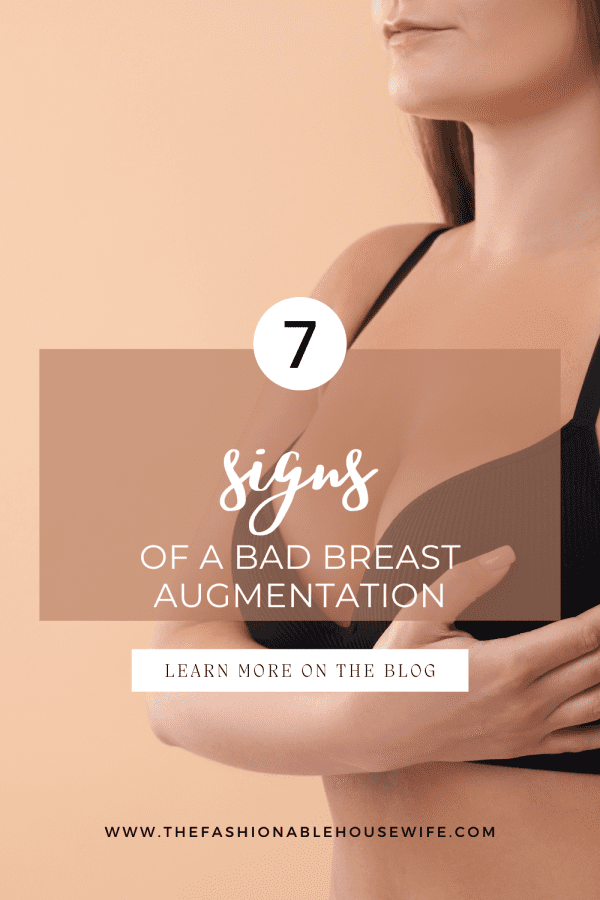7 Signs of a Bad Breast Augmentation

A breast augmentation should enhance your confidence and body image, but when it goes wrong, it can cause discomfort, dissatisfaction, and other health issues. Whether you have silicone breast implants or saline implants, here are 7 red flags that may indicate something is not right after your breast augmentation surgery.
Pain That Will Not Go Away
Mild pain is expected in the first few weeks after surgery. But if you are experiencing persistent breast pain months after your procedure, it could be a sign of a complication such as capsular contracture, nerve damage, or infection. Ongoing discomfort warrants a prompt evaluation by a board-certified plastic surgeon.
Lopsided or Oddly Shaped Breasts
Symmetry is a major goal of any breast surgery. If your breasts are lopsided, unusually positioned, or the breast shape looks abnormal, your implants may have shifted, dropped, or been placed unevenly. This can happen with both saline and silicone breast implants and often requires revision surgery to correct.
Hard, Uncomfortable Implants
A firm or hard implant can signal scar tissue tightening around the implant—a condition known as capsular contracture. This not only distorts the natural breast appearance but can also lead to intense pain. It’s one of the most common signs of breast implant complications and may require the implant to be removed.
Wrinkles or Rippling Under Skin
Visible wrinkling or rippling—especially along the sides or bottom of the breast—can occur when the implant isn’t properly covered by breast tissue. This is more common with saline implants or in patients with little body fat. It can be a cosmetic issue or a sign of implant malposition.
Implants That Move or “Drop” Too Much
A certain degree of implant settling is expected, but if your implants continue to move, drop, or feel like they’re “bottoming out,” they may have shifted out of position. Over time, this can lead to uneven breast shape, discomfort, and dissatisfaction with the appearance of your breast augmentation.
Ruptures or Deflation
Saline implants rupture visibly—your breast may suddenly appear flat or deflated. Silicone implant ruptures, however, are often “silent.” You might not notice until imaging detects the leak. Symptoms can include swelling, pain, or changes in breast shape. Prompt evaluation is crucial, especially in cases of silicone gel leakage.
You Just Hate How They Look
Sometimes, even if there is no medical complication, you may simply be unhappy with your boob job results. Maybe they look too fake, are too large or too small, or don’t match your natural breast shape. You don’t have to live with regret—an experienced surgeon can help you achieve your ideal outcome.
How to Avoid a Bad Breast Augmentation
The best way to prevent breast implant problems is by doing your homework beforehand. Here’s how to stack the odds in your favor:
- Choose a board-certified plastic surgeon. Ensure they are certified by the American Board of Plastic Surgery and have extensive experience with breast augmentation surgery.
- Look at before-and-after galleries. Evaluate their results on women with body types similar to yours.
- Have a detailed consultation. Discuss your goals, lifestyle, and expectations openly. Your surgeon should help you choose the right implant type (e.g., silicone gel vs. saline), size, and placement.
- Understand the risks. No surgery is without risk. Be informed about potential complications like capsular contracture, breast implant rupture, and breast implant illness (BII).
- Follow post-op instructions. Healing is a process. Protect your implants during recovery and follow activity restrictions closely.
Help! My Augmentation Went Wrong – What Now?
If you’re experiencing any of the above signs or just feel something isn’t right, don’t wait. You have options:
- Seek a second opinion. Schedule a consultation with a different board-certified plastic surgeon who specializes in breast revision.
- Get imaging. An MRI or ultrasound may be needed to detect silicone implant ruptures.
- Consider explant surgery. If you’re experiencing symptoms like pain or simply want your implants removed, explant surgery with or without lift may be a suitable option.
- Do not ignore your instincts. While breast implant illness (BII) is not officially recognized as a medical diagnosis, some non-specific symptoms may be indicative of other underlying issues like infection.
FAQ Section
How do I know if my breast implants are bad?
Watch for changes in breast shape, ongoing breast pain, firmness, visible rippling, or acute symptoms like pain. Sudden deflation or visible distortion are also clear indicators that something is wrong.
What does a bad breast augmentation look like?
A poor result may include lopsided breasts, implants sitting too high or too low, asymmetry, unnatural contours, or visible wrinkling and rippling. In severe cases, implants may rotate, harden, or appear displaced.
What is not normal after breast augmentation?
While swelling and discomfort are normal in early recovery, symptoms like sharp pain, persistent redness, fever, or visible implant shifting are not. Contact your surgeon if you notice any of these issues.
When should I worry after breast augmentation?
You should seek prompt care if:
- Pain persists beyond the expected recovery period
- Your breast suddenly changes size or shape
- You feel a lump or abnormal firmness
- You experience symptoms of breast implant rupture or infection.
Scheduling a Consultation
If you are experiencing signs of a bad breast augmentation—or simply want a professional opinion—schedule a consultation with a board-certified plastic surgeon.
At your visit, a specialist will evaluate your breast tissue, check for scar tissue formation or capsular contracture, and possibly order imaging to detect silicone implant ruptures or other structural concerns. Whether your implants are saline or silicone gel, an expert can help determine the best path forward—whether that is a revision, having your breast implants removed, or exploring non-surgical options to restore a natural breast appearance.

